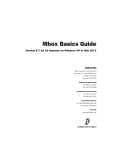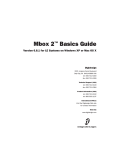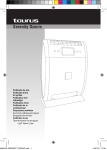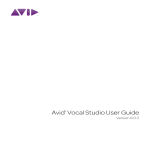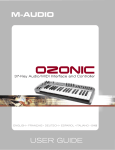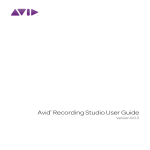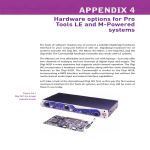Download M-Audio Ozonic Specifications
Transcript
M-Powered Basics Guide Version 6.8 for M-Powered Systems on Windows or Macintosh Digidesign 2001 Junipero Serra Boulevard Daly City, CA 94014-3886 USA tel: 650·731·6300 fax: 650·731·6399 Technical Support (USA) tel: 650·731·6100 fax: 650·731·6384 Product Information (USA) tel: 650·731·6102 tel: 800·333·2137 International Offices Visit the Digidesign Web site for contact information Web Site www.digidesign.com Copyright This guide is copyrighted ©2005 by Digidesign, a division of Avid Technology, Inc. (hereafter “Digidesign”), with all rights reserved. Under copyright laws, this guide may not be duplicated in whole or in part without the written consent of Digidesign. DIGIDESIGN, AVID, M-Audio, and PRO TOOLS are trademarks or registered trademarks of Digidesign and/or Avid Technology, Inc. All other trademarks are the property of their respective owners. Product features, specifications, system requirements and availability are subject to change without notice. PN 9320-17065-00 REV A 4/05 Introduction Welcome to the M-Powered Basics Guide. This guide is designed to give new users specific methods for accomplishing common tasks with Digidesign-qualified M-Audio interfaces and Pro Tools M-Powered software. Online Resources Once you are familiar with basic M-Powered operation, we recommend that you read the “Working With Pro Tools” tutorial in the Getting Started with Pro Tools M-Powered Guide. For the most complete resource for using Pro Tools software, please refer to the Pro Tools Reference Guide. DiSK (Digidesign Sound Knowledge) Instructional material about how to use Pro Tools, including DiSK Flix movies that show how to do a number of popular tasks using Pro Tools. Many resources for learning to use Pro Tools are also available online at the Digidesign Web site (www.digidesign.com), including the following: DigiZine A magazine for and about Pro Tools users, providing all the latest product news, user stories, and hundreds of tips and ideas. M-Powered Basics Requirements Before proceeding, make sure you have: • Connected the Digidesign-qualified M-Audio interface to your computer, as described in your M-Audio documentation. – and – • Installed Pro Tools M-Powered software and the pre-authorized iLok, as described in the appropriate Windows or Macintosh installation chapter of the Getting Started with Pro Tools M-Powered Guide. Introduction 1 Getting Sound In and Out of your M-Audio Interface To hear audio recorded into a Pro Tools session, you will need to connect headphones or an external sound system (such as powered monitors or a home stereo) to your M-Audio interface. Sound from your M-Audio interface cannot be played through your computer’s speakers or your computer’s sound output. Connecting Headphones Depending on which M-Audio interface you have, there will be one or more headphone jacks on the front or back of your interface. These can be either a 1/4-inch jack or a 1/8-inch mini plug jack. 1/4-inch Headphone jack To connect headphones: • Connect headphones with a 1/4-inch stereo connector (or an adapter) to interfaces that have a 1/4-inch Headphone jack. – or – • Connect headphones with a 1/8-inch stereo mini connector (or an adapter) to interfaces that have a 1/8-inch Headphone jack. Some M-Audio interfaces include a front panel Headphone control to adjust the volume level of the Headphone jacks. Connecting a Sound System Depending on which M-Audio interface you have, the outputs will be 1/4-inch or RCA plugs, and the 1/4-inch connections can be balanced, TRS style connectors, or unbalanced. To listen to your Pro Tools session, these outputs can be connected to any amplification system: powered speakers, home stereo system, or an audio mixer. Headphone jacks on the front of a FireWire 1814 1/4-inch Headphone jack Headphone jack on the back of an Ozonic 2 M-Powered Basics Guide When connecting to a stereo system, connect the left channel (often the white plug) to the first output, and right channel (often the red plug) to the second output. Home stereo systems often use RCA connectors. You can use an adaptor or a special cable to convert from the TRS or TS connectors (used on some M-Audio interfaces) to the RCA connectors on your home stereo. Connecting Audio Inputs Output 1 (left output) Depending on which M-Audio interface you have, the inputs will be 1/4-inch, RCA, or a 1/4inch and XLR combination plug for microphones and for instruments that usually have a lower level (such as guitars). Output 2 (right output) For information about connecting specific audio sources, see “Attaching a Microphone to Your M-Audio Interface” on page 4, and “Connecting Instruments to an M-Audio Interface” on page 6. 1/4-inch stereo outputs on a FireWire 1814 Monitor Left (left output) Monitor Right (right output) For stereo inputs, use the first input for the left input, and the second input for the right input. For additional stereo inputs, use subsequent input pairs, if available. 1/4-inch stereo (monitor) outputs on an Audiophile 192 Analog Out 1 (left output) Analog Out 2 (right output) RCA stereo outputs on an Audiophile 2496 The first and second outputs play the audio that is routed to analog outputs 1 and 2 within Pro Tools. Getting Sound In and Out of your M-Audio Interface 3 Connecting a Microphone Attaching a Microphone to Your M-Audio Interface There can be several ways to use an M-Audio interface with a microphone, depending on the type of microphone and cables that you use, and the type of M-Audio interface. Some microphone cables use an XLR connector to attach a microphone to an input; other microphones use a 1/4-inch connector. If you have a choice, use an XLR connector to connect the microphone to your M-Audio interface to yield better results. XLR connector 1/4-inch connector Most condenser microphones (such as an AKG C3000) require phantom power to operate. Dynamic microphones (such as a Shure SM57) do not require phantom power to operate, but are not harmed by it. Although phantom power can be used safely with most microphones, it is possible to damage some ribbon microphones with it. Always turn off phantom power and wait at least ten seconds before connecting a ribbon microphone. M-Audio interfaces can only supply power through a microphone cable with XLR connectors. If you are not sure about the phantom power requirements for your microphone, consult your microphone’s documentation or contact the manufacturer. To use a microphone that has an XLR connector: XLR and 1/4-inch connectors 1 Plug your microphone cable into one of the Phantom Power Mic (or Mic/Inst) inputs on your M-Audio interface. Some microphones require power to operate. This power, called phantom power, is supplied either by a battery in the microphone, or through an audio interface (such as some M-Audio interfaces) that can supply power through the microphone cable. M-Audio interfaces that support phantom power can only provide phantom power when their “wall wart” power supply is used to power the interface. Check your MAudio interface guide for details 4 M-Powered Basics Guide Mic/Inst 1 XLR connector plugged into Mic/Inst input on a FireWire 1814 To use a microphone that has a 1/4-inch connector: 1 Plug the 1/4-inch connector from your micro- phone into one of the Mic (or Mic/Inst) 1/4inch inputs on your M-Audio interface. Mic input XLR connector plugged into Mic input on an Ozonic 2 If your M-Audio interface has a Mic/Line switch, press it to its out position. 1/4-inch connector plugged into Mic/Inst input on a FireWire 1814 2 If your M-Audio interface has a Mic/Line se- Mic/Line selector lector, press it to its out position. Mic/Line selector Mic/Line selector on the front of a FireWire 1814 3 If your microphone requires phantom power, make sure the microphone is connected, then press the Phantom Power switch on your M-Audio interface. This switch sends 48V to each mic input. The Phantom Power LED on your M-Audio interface will light when phantom power is being supplied. Mic/Line selector on the front of a FireWire 1814 3 If your M-Audio interface has a Signal Gain control, carefully turn the control for the input to the right to increase the input level of your microphone signal. Phantom Power switch Phantom Power switch on a FireWire 1814 4 If your M-Audio interface has a Signal Gain Signal Gain Control Signal Gain control on a FireWire 1814 control, carefully turn the control for the input to the right to increase the input level of your microphone signal. Connecting a Microphone 5 Connecting Instruments Connecting Instruments to an M-Audio Interface Instruments such as electric guitar or electric bass usually have a lower level of output than instruments and electronic audio sources such as mixers, samplers, keyboards, turntables, and synthesizers. 2 If your M-Audio interface has a Mic/Line se- lector, press it to its out position. Mic/Line selector To use a guitar with your M-Audio interface: Mic/Line selector on the front of a FireWire 1814 1 Plug your guitar cable into one of the inputs 3 If your M-Audio interface has a Signal Gain on your M-Audio interface. On M-Audio interfaces that have separate inputs for lower level sources (such as guitars) and line level sources (such as keyboards), use the inputs that support your source. Mic/Inst 1 Guitar cable plugged into Mic/Inst input on a FireWire 1814 Input 2 Guitar cable plugged into Input 2 on an Ozonic 6 M-Powered Basics Guide control, carefully turn the control for the input to the right to increase the input level of your microphone signal. To use a keyboard or mixer with your M-Audio interface: 2 If your M-Audio interface has a Mic/Line se- lector, press it to its In position. 1 Plug your keyboard, mixer, or other audio source into one of the inputs on your M-Audio interface. On M-Audio interfaces that have separate inputs for lower level sources (such as guitars) and line level sources (such as keyboards), use the inputs that support your source. If your source is stereo (such as a stereo keyboard or the stereo output from a mixer), connect the left channel (often the white plug) to the first input, and right channel (often the red plug) to the second input. Mic/Line selector Mic/Line selector on the front of a FireWire 1814 3 Set your instrument’s volume to its optimal level. For example, the optimal level for most keyboards is between 80% and 100% of maximum volume. 4 If your M-Audio interface has a Signal Gain Input 1 (left channel) control, carefully turn the control for the input to the right to increase the input level of your microphone signal. Input 2 (right channel) FireWire 1814 configuration for stereo input Analog In 1 (left channel) Analog In 2 (right channel) Audiophile 2496 configuration for stereo input Connecting Instruments 7 Recording a Pro Tools Session Recording with Pro Tools M-Powered involves creating a Pro Tools session, preparing an audio track for recording, and recording. To prepare an audio track for recording: To create a session in Pro Tools: 2 Specify 1 Mono Audio Track in Samples, if 1 Verify the connections between your M-Audio your source is mono, or 1 Stereo Audio Track in Samples, if your source is stereo. interface and your instrument or microphone. 1 Create a new track to record on by choosing File > New Track. 2 Launch Pro Tools. 3 Choose File > New Session. 4 Set Session Parameters in the New Session dialog as needed, or leave them at their default settings. (For details on New Session settings, see the Getting Started with Pro Tools M-Powered Guide.) Creating a new stereo audio track 3 Click Create. A mono instrument uses one input on an MAudio interface, and a stereo instrument uses two. Creating a stereo track in Pro Tools will not make a mono instrument into a stereo instrument. If a mono instrument is recorded on a stereo track, one of the sides of the stereo track will show no signal. 4 Make certain the Mix window is open by choosing Windows > Show Mix. Showing the Mix widow 5 In the Mix window, click the Input Selector on the new track. New Session dialog 5 Select where you want to save your session. Input selector 6 Type a name for your session. 7 Click Save. Pro Tools creates a new session. Choosing an input in the Mix window 8 M-Powered Basics Guide 6 From the pop-up menu, select the interface in- 2 Choose Windows > Show Transport to display put you want to record. For example, select Mic/Line 1 if your audio source is plugged into the first input of your M-Audio interface. the Transport window. Click Return To Zero (or press Enter) to cue to the beginning of the session. Return To Zero Fast Forward Rewind Play Go to End Stop Record Routing an input to a mono track 7 Use the Signal Gain controls on your M-Audio interface (if any) to maximize the signal going into Pro Tools while avoiding clipping. Transport window Clipping occurs when you feed a signal to an audio device that is louder than the circuitry can accept. To avoid clipping, adjust the Signal Gain control (if any). If the MAudio interface has front panel Clip LEDS, adjust the gain to a level where the Peak LEDs flicker occasionally. 3 Click Record in the Transport window to arm Pro Tools for recording. The Record button will flash red to indicate that Pro Tools is ready to record. 4 When you are ready to start recording, click Play or press the Spacebar. To record an audio track: 5 Record your performance. 1 Click the Record Enable button for the track. 6 Click Stop in the Transport window or press the Spacebar when you are finished recording. To play back a recorded track: 1 If the track’s Record Enable button is lit, click on it to take it out of Record mode. 2 Click Play in the Transport window or press Record enabling a track in the Mix window the Spacebar to start playback. 3 Click Stop in the Transport window or press the Spacebar to stop playback. Recording a Pro Tools Session 9 Impor ting Audio from a CD To import audio from a compact disc: 1 Put the source CD into your computer’s CD drive. 8 In the session, create a new track by choosing File > New Track. 2 Use a third party software program of your choice to extract audio from the CD. 3 Launch Pro Tools. 4 Choose File > New Session. 5 Set Session Parameters in the New Session di- alog as needed, or leave at their default settings. (For details, see the Getting Started with Pro Tools M-Powered Guide.) Creating a new stereo audio track 9 In the New Track dialog, specify 1 Stereo Au- dio Track in Samples, and click Create. 10 Open the Workspace Browser by choosing Windows > Show Workspace. The Workspace Browser is a window where you can find, audition, and manage your audio files. Opening the Workspace Browser 11 In the Workspace Browser, navigate to the lo- cation where you saved the audio you extracted from your CD in step 2. New Session dialog 6 Select where you want to save your session. 7 Type a name for your session and click Save. Pro Tools creates a new session. 10 M-Powered Basics Guide Browsing in the Workspace Browser 12 Click and hold on the speaker icon in the waveform window to audition the audio file. To play back the new track: 1 In the Transport window, click Return To Zero to cue the beginning of the track. 2 Click Play in the Transport window to begin playback. The CD track you extracted should begin playing back. Auditioning an audio file in the Workspace Browser 13 Drag the audio file from the Workspace Browser to the audio track you created in your session. Dragging the audio file from the Workspace Browser to an audio track Importing Audio from a CD 11 Creating an Audio CD from a Pro Tools Session Pro Tools does not create audio CDs directly, but you can create stereo audio files from your Pro Tools sessions that can be used by most common CD burning programs. 2 Choose File > Bounce to Disk. Use the Pro Tools Bounce to Disk feature to combine all your audible tracks into a single “master” audio file. After the new audio file has been bounced to disk, you can burn it to a CD. Bouncing Audio to Disk To bounce audio to disk: 1 After you have finished recording and mixing a session in Pro Tools, highlight the length of the session in the timeline ruler (or on a track), plus an additional amount of time to avoid cutting off any reverb tails that might continue past the end of the region. Choosing Bounce to Disk from the file menu 3 In the Bounce Options dialog, choose Analog Outputs 1–2 as the Bounce Source. 4 Choose BWF (.WAV) for the File Type. 5 Choose Stereo Interleaved for the Format. 6 Choose 16 for the Resolution and 44100 for the Sample Rate. 7 Set the Conversion Quality. For the best quality, choose Tweak-Head (Slowest). Audio session highlighted and ready to bounce 12 M-Powered Basics Guide 8 Choose “Convert after Bounce,” and click Bounce. 10 Click Save. Pro Tools will begin bouncing to disk. Pro Tools bounces are done in real time, so you hear audio playback of your mix during the bounce process (though you cannot adjust it). . Bouncing to Disk dialog Burning a CD Bounce options for creating CD burnable tracks 9 In the Save Bounce As dialog, give the bounce tracks a name and choose where they should be saved. After the bounce is completed, you will have an audio file that is ready for burning onto a CD. Quit Pro Tools and launch any common thirdparty CD burning application to burn your bounced mix to CD. Make certain that you configure your CD burning application to create an audio CD rather than a data CD. Save Bounce As dialog Creating an Audio CD from a Pro Tools Session 13 M-Powered and MIDI 2 Choose File > New Track and specify 1 MIDI What is MIDI? MIDI (Musical Instrument Digital Interface) is not audio, and has no sound. MIDI is a way for musical devices to communicate. MIDI is data that can trigger a MIDI device (such as a keyboard or software synthesizer). Track, then click Create. 3 In the Mix window, click the track’s MIDI In- put Selector and assign the device and channel that will be recorded. In order to create or play a MIDI recording, you must have a MIDI keyboard or sound module (real or virtual) connected to the computer through a MIDI interface. Audio from your MIDI instrument can be sent to an external mixer or monitored through your M-Audio interface. Some M-Audio interfaces (such as Ozonic) are also a MIDI keyboard with MIDI ports. Other M-Audio interfaces (such as Audiophile 192) include MIDI ports. Refer to your M-Audio interface guide for details. MIDI sound module MIDI MIDI Input Selector 4 In the Mix window, click on the track’s MIDI Output Selector and choose the destination (assignment) for that MIDI track by choosing a MIDI interface port, a channel, or a device from the pop-up menu (choices vary depending on the operating system and Pro Tools version). Audio To amplifier MIDI keyboard (controller) Mixer Signal paths for MIDI instruments For more information on monitoring through your M-Audio interface, see “Monitoring MIDI Instruments Without a Mixer” on page 15. To configure a MIDI track for recording: 1 On Macintosh systems, choose MIDI > Input Devices and make sure your input device is selected in the MIDI Input Enable window. 14 M-Powered Basics Guide MIDI Output Selector 5 In the Mix Window, record-enable the MIDI track. 6 Make sure MIDI > MIDI Thru is selected, then play some notes on your MIDI controller. The track’s meters move. Remember, MIDI is not audio, and the meters are not registering sound, but MIDI activity. To monitor your MIDI instrument’s analog outputs in Pro Tools, refer to “Monitoring MIDI Instruments Without a Mixer” on page 15. You can also monitor your MIDI instrument’s analog outputs by using an external mixer. To record a MIDI track: 1 Verify that the MIDI track you want to record to is record-enabled and receiving MIDI. 2 In the Transport window, click Return To Zero to start recording from the beginning of the session. You can also record according to a selection or from the cursor location in the Edit window. 3 Click Record in the Transport window. 4 Click Play in the Transport window or press the Spacebar to begin recording. 5 Play your MIDI instrument. 6 When you have finished recording, click Stop in the Transport window, or press the Spacebar. The newly recorded MIDI data appears as a MIDI region on the track in the Edit window, as well as in the MIDI Regions List. To play back a recorded MIDI track: 1 Click the Record Enable button to take the MIDI track out of Record mode. 2 In the Transport window, click Return To Zero to play back from the beginning of the track. 3 Click Play in the Transport window to begin playback. The recorded MIDI data plays back through the track’s assigned instrument and channel. Monitoring MIDI Instruments Without a Mixer To monitor your MIDI instrument’s analog output in Pro Tools, you can use an Auxiliary Input. Auxiliary Inputs function as inputs for both internally bussed signals and external audio sources. To configure an Auxiliary Input for MIDI monitoring: 1 Connect the MIDI instrument’s audio output to the appropriate inputs on your M-Audio interface. 2 Choose File > New Track and specify 1 mono or stereo Auxiliary Input, then click Create. 3 Click the Input selector of the Auxiliary Input channel and choose the input to which your MIDI instrument is connected to the M-Audio interface. 4 Adjust the level of the Auxiliary Input with its volume fader. Now you will hear the audio output of your MIDI device in Pro Tools. M-Powered and MIDI 15 Controlling Delay (Latency) During Monitoring Because Pro Tools M-Powered uses your computer for all audio processing, playback, and recording, there is a small amount of audio delay, or latency, in the system. To set the Hardware Buffer Size: 1 Choose Setups > Playback Engine. 2 Choose the number of samples from the H/W Buffer Size pop-up menu. Latency is most obvious when monitoring during recording. You may hear this as a slight delay between when you produce the sound and when you hear the sound through the speakers or headphones. This amount of latency is related to the H/W Buffer Size—the larger the buffer size the larger the latency. You can reduce the amount of monitoring latency for Pro Tools systems by reducing the H/W Buffer Size. However, even at the smallest buffer size, there is still some latency. In addition, reducing the buffer size limits the number of simultaneous audio tracks you can record without encountering performance errors, and reduces the number of plug-ins you can use. While there may be times when you want a larger buffer size, for the sake of higher track counts with more plug-ins, you will generally want a smaller buffer size when recording audio that is monitored through your Pro Tools system. If you are monitoring the recording source with an external mixer, before it is routed to Pro Tools, you will not hear any latency. Some M-Audio interfaces provide additional hardware monitoring options. Refer to your M-Audio interface guide for details. 16 M-Powered Basics Guide 3 Click OK. Computers with slower CPUs may not be able to use the 128 buffer size without encountering performance errors.


















